Sparse DOD/DOA Estimation in a Bistatic MIMO Radar With Mutual Coupling Effect
Abstract
:1. Introduction
- Sparse DOD/DOA estimation model with mutual coupling effect: In the bistatic MIMO radar system, the DOD/DOA estimation model is proposed based on the sparse reconstruction model, and the unknown mutual coupling effect between antennas is also considered.
- Sparse DOD/DOA estimation method with off-grid effect: In the sparse reconstruction methods, the detection area is discretized into grids to formulated the dictionary matrix, so the off-grid effect limits the reconstruction performance. Therefore, combining both off-grid effect and mutual coupling effect, the sparse DOD/DOA estimation method is proposed.
- Theoretical CRLB expression for DOD/DOA estimation with mutual coupling effect: The corresponding CRLB with the unknown mutual coupling effect is theoretically derived to describe the estimation performance.
2. The System Model of Bistatic MIMO Radar
2.1. Bistatic MIMO Radar System without Mutual Coupling
2.2. Bistatic MIMO Radar System With Mutual Coupling
3. DOA/DOD and Mutual Coupling Matrix Estimation
3.1. CS-Based DOD/DOA Estimation
| Algorithm 1 Simultaneous orthogonal matching pursuit for DOD/DOA estimation |
|
3.2. Gradient Decent-Based Mutual Coupling Matrix Estimation
| Algorithm 2 Mutual coupling matrix estimation |
|
3.3. Polish the Estimated DOD/DOA and Mutual Coupling Matrix
| Algorithm 3 Polish the estimated DOD/DOA and mutual coupling matrix |
|
- 1.
- The k-th column ofis
- 2.
- The k-th column ofis
- 3.
- The m-th column ofis
- 4.
- The n-th column ofis
- 5.
- The m-th entry ofis
- 6.
- The n-th entry ofis
4. Cramér–Rao Lower Bound
- is obtained aswhere the k-th column of isandWith the same method, we can obtain .
- is obtained asand we have .
- is obtained aswhere the n-th column of is
- is obtained aswhere the n-th column of is
5. Computational Complexity
6. Simulation Results
7. Conclusions
Author Contributions
Funding
Conflicts of Interest
Appendix A. The Derivations of Complex Vector and Matrix
References
- Li, J.; Stoica, P. MIMO radar with colocated antennas. IEEE Signal Process. Mag. 2007, 24, 106–114. [Google Scholar] [CrossRef]
- Haimovich, A.M.; Blum, R.S.; Cimini, L.J. MIMO radar with widely separated antennas. IEEE Signal Process. Mag. 2007, 25, 116–129. [Google Scholar] [CrossRef]
- Fishler, E.; Haimovich, A.; Blum, R.; Chizhik, D.; Cimini, L.; Valenzuela, R. MIMO radar: An idea whose time has come. In Proceedings of the IEEE Radar Conference, Philadelphia, PA, USA, 26–29 April 2004; pp. 71–78. [Google Scholar]
- Chen, P.; Qi, C.; Wu, L.; Wang, X. Estimation of Extended Targets Based on Compressed Sensing in Cognitive Radar System. IEEE Trans. Veh. Technol. 2017, 66, 941–951. [Google Scholar] [CrossRef]
- Fishler, E.; Haimovich, A.; Blum, R.S.; Cimini, L.J.; Chizhik, D.; Valenzuela, R.A. Spatial diversity in radars-models and detection performance. IEEE Trans. Signal Process. 2006, 54, 823–838. [Google Scholar] [CrossRef]
- Davis, M.; Showman, G.; Lanterman, A. Coherent MIMO radar: The phased array and orthogonal waveforms. IEEE Aerosp. Electron. Syst. Mag. 2014, 29, 76–91. [Google Scholar] [CrossRef]
- Chen, P.; Wu, L.; Qi, C. Waveform Optimization for Target Scattering Coefficients Estimation Under Detection and Peak-to-Average Power Ratio Constraints in Cognitive Radar. Circ. Syst. Signal Process. 2016, 35, 163–184. [Google Scholar] [CrossRef]
- Chen, P.; Qi, C.; Wu, L. Antenna placement optimisation for compressed sensing-based distributed MIMO radar. IET Radar Sonar Navig. 2017, 11, 285–293. [Google Scholar] [CrossRef]
- Willis, N.J.; Griffiths, H.D. Advances in Bistatic Radar; Institution of Engineering and Technology: Stevenage, UK, 2007. [Google Scholar]
- Zhang, J.; Wang, H.; Zhu, X. Adaptive waveform design for separated transmit/receive ULA-MIMO radar. IEEE Trans. Signal Process. 2010, 58, 4936–4942. [Google Scholar] [CrossRef]
- Yao, B.; Wang, W.; Yin, Q. DOD and DOA estimation in bistatic non-uniform multiple-input multiple-output radar systems. IEEE Commun. Lett. 2012, 16, 1796–1799. [Google Scholar] [CrossRef]
- Jiang, H.; Zhang, J.K.; Wong, K.M. Joint DOD and DOA estimation for bistatic MIMO radar in unknown correlated noise. IEEE Trans. Veh. Technol. 2015, 64, 5113–5125. [Google Scholar] [CrossRef]
- Chen, P.; Qi, C.; Wu, L.; Wang, X. Waveform Design for Kalman Filter-Based Target Scattering Coefficient Estimation in Adaptive Radar System. IEEE Trans. Veh. Technol. 2018. [Google Scholar] [CrossRef]
- Zhang, X.; Xu, L.; Xu, L.; Xu, D. Direction of departure (DOD) and direction of arrival (DOA) estimation in MIMO radar with reduced-dimension MUSIC. IEEE Commun. Lett. 2010, 14, 1161–1163. [Google Scholar] [CrossRef]
- Bencheikh, M.L.; Wang, Y. Joint DOD-DOA estimation using combined ESPRIT-MUSIC approach in MIMO radar. Electron. Lett. 2010, 46, 1796–1799. [Google Scholar] [CrossRef]
- Zheng, G.; Tang, J.; Yang, X. ESPRIT and unitary ESPRIT algorithms for coexistence of circular and noncircular signals in bistatic MIMO radar. IEEE Access 2016, 4, 7232–7240. [Google Scholar] [CrossRef]
- Oh, D.; Li, Y.C.; Khodjaev, J.; Chong, J.W.; Lee, J.H. Joint estimation of direction of departure and direction of arrival for multiple-input multiple-output radar based on improved joint ESPRIT method. IET Radar Sonar Navig. 2015, 9, 308–317. [Google Scholar] [CrossRef]
- Zhang, C.; Huang, H.; Liao, B. Direction finding in MIMO radar with unknown mutual coupling. IEEE Access 2017, 5, 4439–4447. [Google Scholar] [CrossRef]
- Zheng, Z.; Zhang, J.; Zhang, J. Joint DOD and DOA estimation of bistatic MIMO radar in the presence of unknown mutual coupling. Signal Process. 2012, 92, 3039–3048. [Google Scholar] [CrossRef]
- Chen, P.; Zheng, L.; Wang, X.; Li, H.; Wu, L. Moving target detection using colocated MIMO radar on multiple distributed moving platforms. IEEE Trans. Signal Process. 2017, 65, 4670–4683. [Google Scholar] [CrossRef]
- Liu, X.L.; Liao, G.S. Multi-target localisation in bistatic MIMO radar. Electron. Lett. 2010, 46, 945–946. [Google Scholar] [CrossRef]
- Skolnik, M. Radar Handbook, 3rd ed.; McGraw-Hill: New York, NY, USA, 2008. [Google Scholar]
- Maio, A.D.; Landi, L.; Farina, A. Adaptive radar detection in the presence of mutual coupling and near-field effects. IET Radar Sonar Navig. 2008, 2, 17–24. [Google Scholar] [CrossRef]
- Lin, M.; Yang, L. Blind calibration and DOA estimation with uniform circular arrays in the presence of mutual coupling. IEEE Antennas Wirel. Propag. Lett. 2006, 5, 315–318. [Google Scholar] [CrossRef]
- Liu, C.L.; Vaidyanathan, P.P. Super nested arrays: Linear sparse arrays with reduced mutual coupling—Part I: Fundamentals. IEEE Trans. Signal Process. 2016, 64, 3997–4012. [Google Scholar] [CrossRef]
- Candes, E.J.; Wakin, M.B. An introduction to compressive sampling. IEEE Signal Process. Mag. 2008, 25, 21–30. [Google Scholar] [CrossRef]
- Donoho, D.L. Compressed sensing. IEEE Trans. Inf. Theory 2006, 52, 1289–1306. [Google Scholar] [CrossRef]
- Li, Y.; Chi, Y. Off-the-grid line spectrum denoising and estimation with multiple measurement vectors. IEEE Trans. Signal Process. 2016, 64, 1257–1269. [Google Scholar] [CrossRef]
- Choi, J.W.; Shim, B. Statistical recovery of simultaneously sparse time-varying signals from multiple measurement vectors. IEEE Trans. Signal Process. 2015, 22, 6136–6148. [Google Scholar] [CrossRef]
- Jin, Y.; Rao, B.D. Support recovery of sparse signals in the presence of multiple measurement vectors. IEEE Trans. Inf. Theory 2013, 59, 3139–3157. [Google Scholar] [CrossRef]
- Zheng, L.; Maleki, A.; Weng, H.; Wang, X.; Long, T. Does ℓp-minimization outperform ℓ1-minimization? IEEE Trans. Inf. Theory 2017, 63, 6896–6935. [Google Scholar] [CrossRef]
- Determe, J.F.; Louveaux, J.; Jacques, L.; Horlin, F. On the noise robustness of simultaneous orthogonal matching pursuit. IEEE Trans. Signal Process. 2017, 65, 864–875. [Google Scholar] [CrossRef]
- Petersen, K.B.; Pedersen, M.S. The Matrix Cookbook; Technical University of Denmark: Lyngby, Denmark, 2008; Volume 7, p. 15. [Google Scholar]

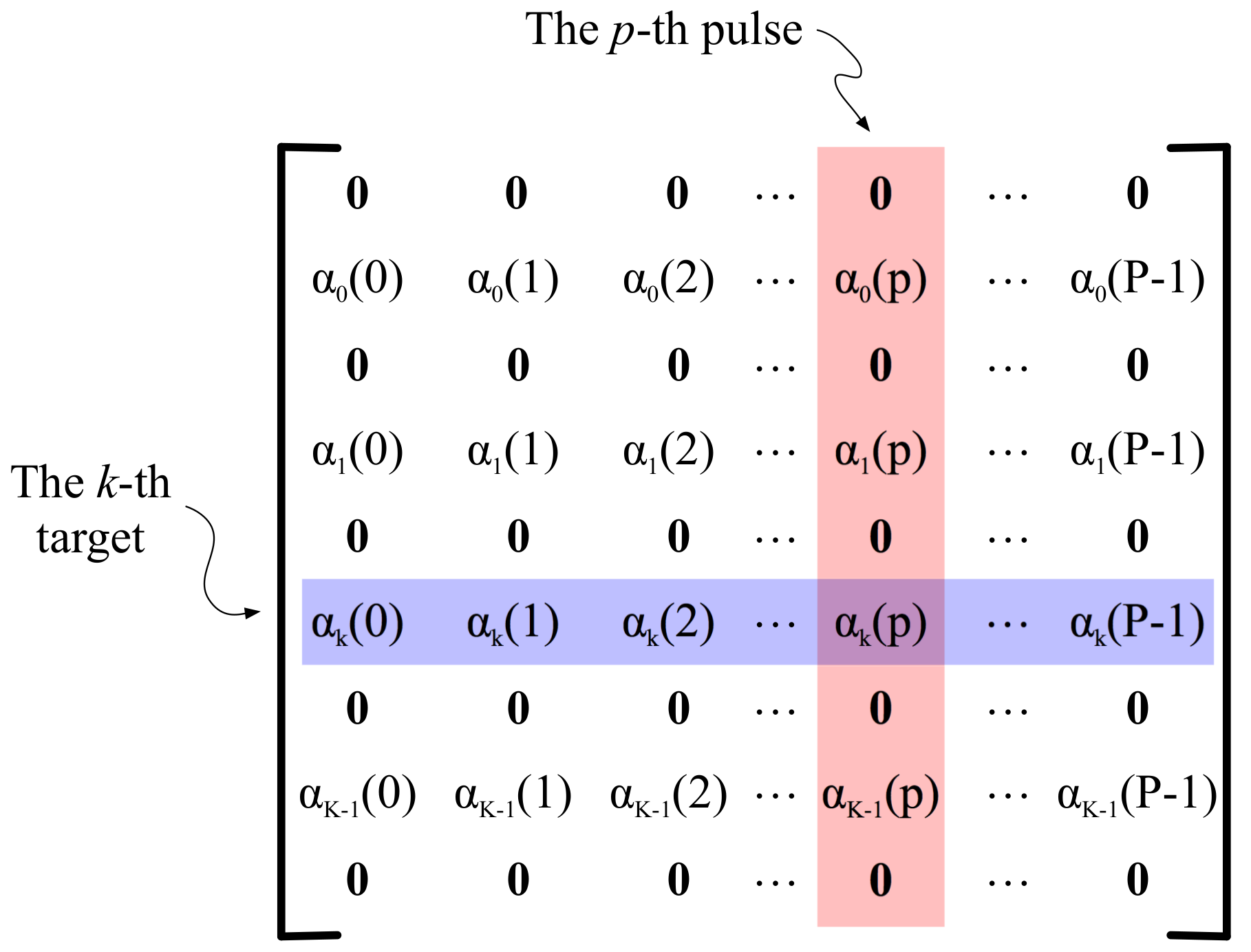
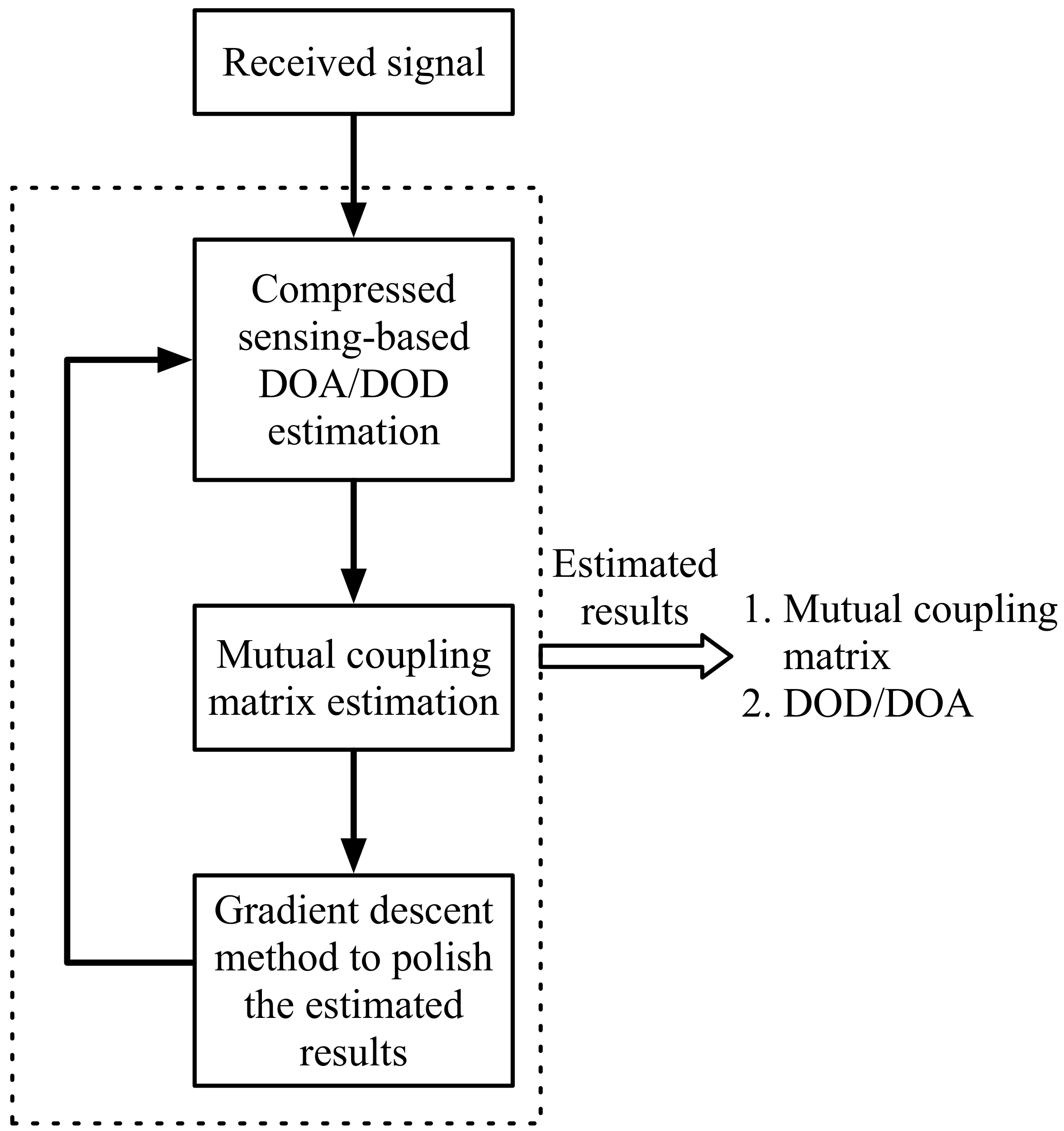
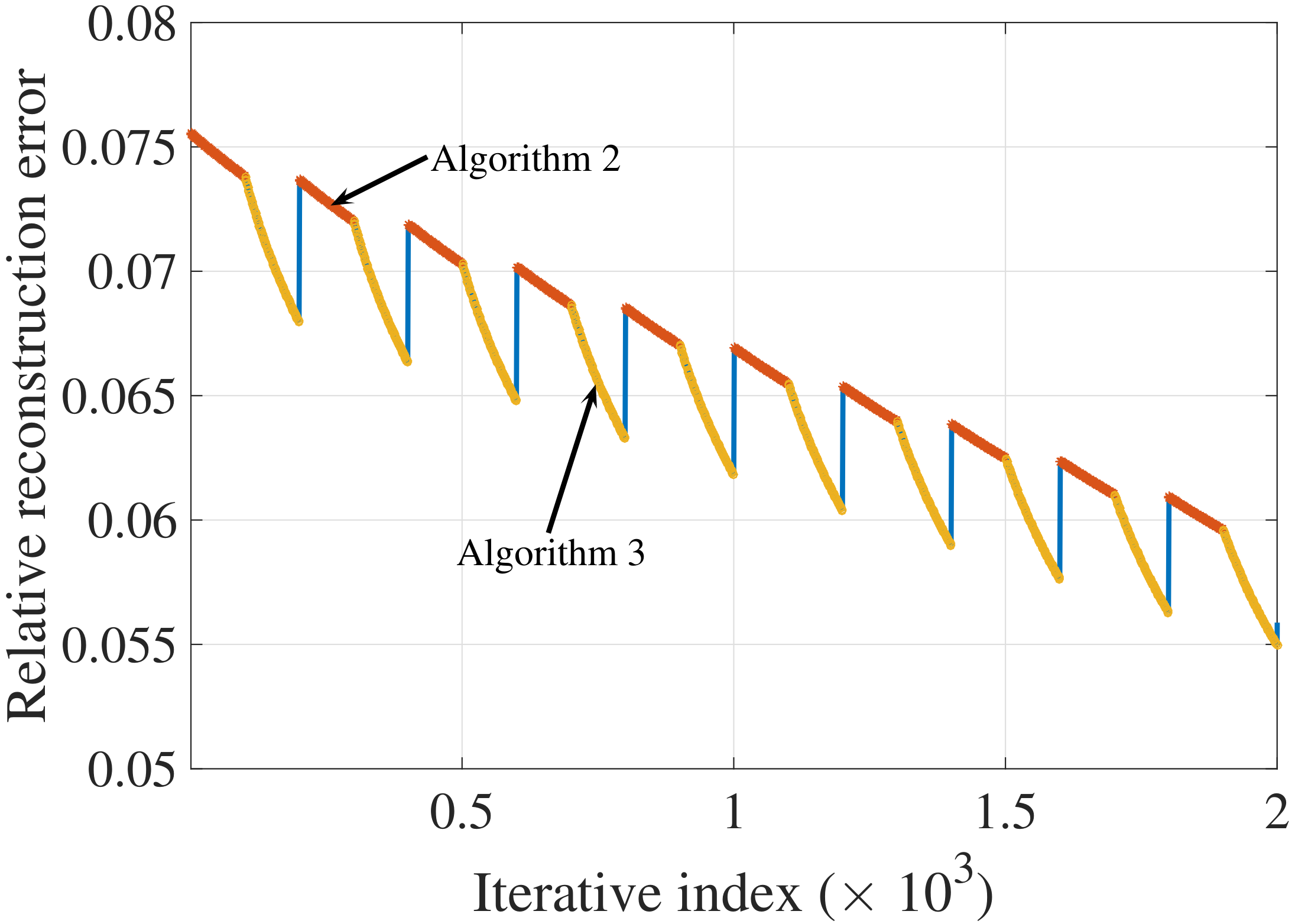
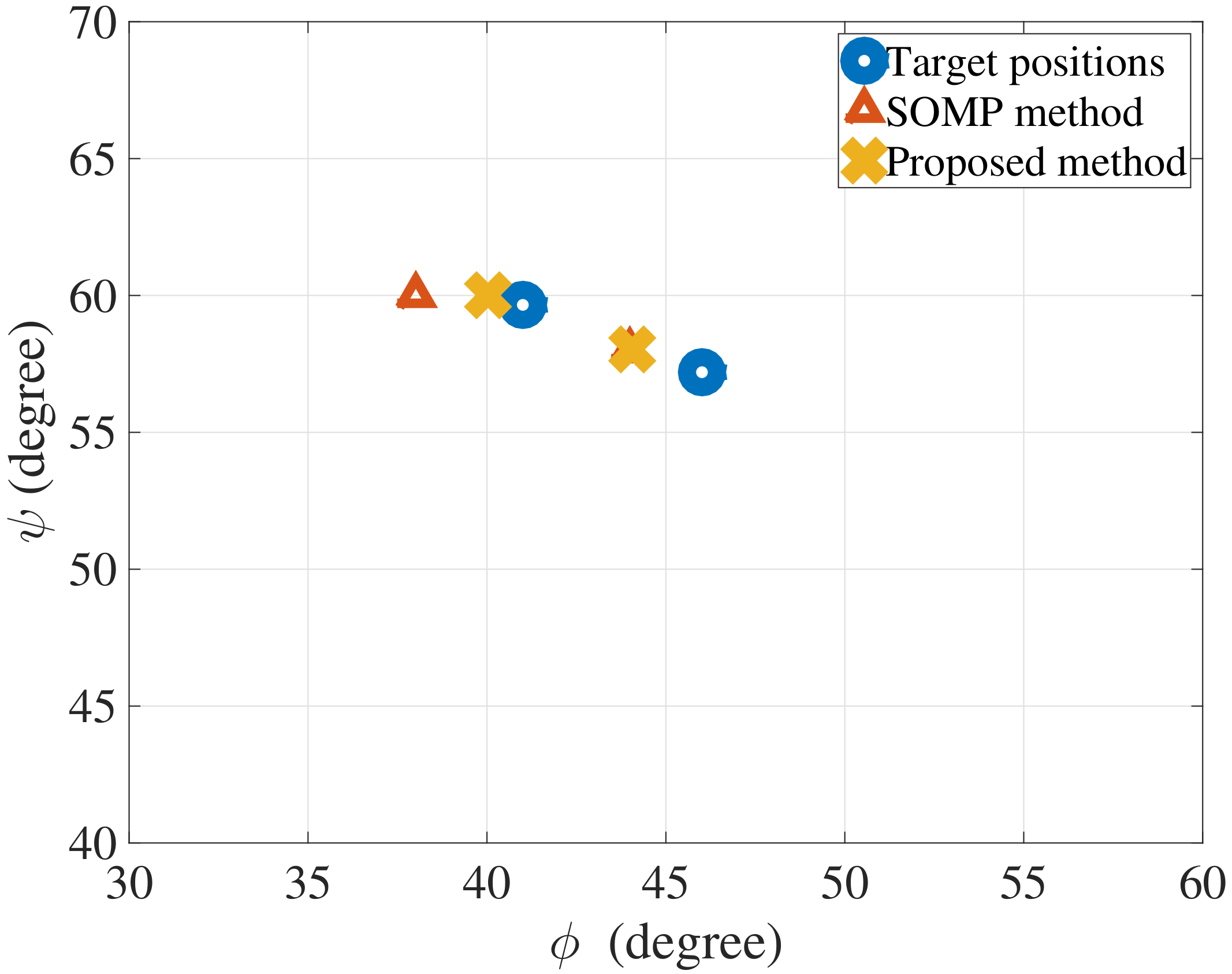
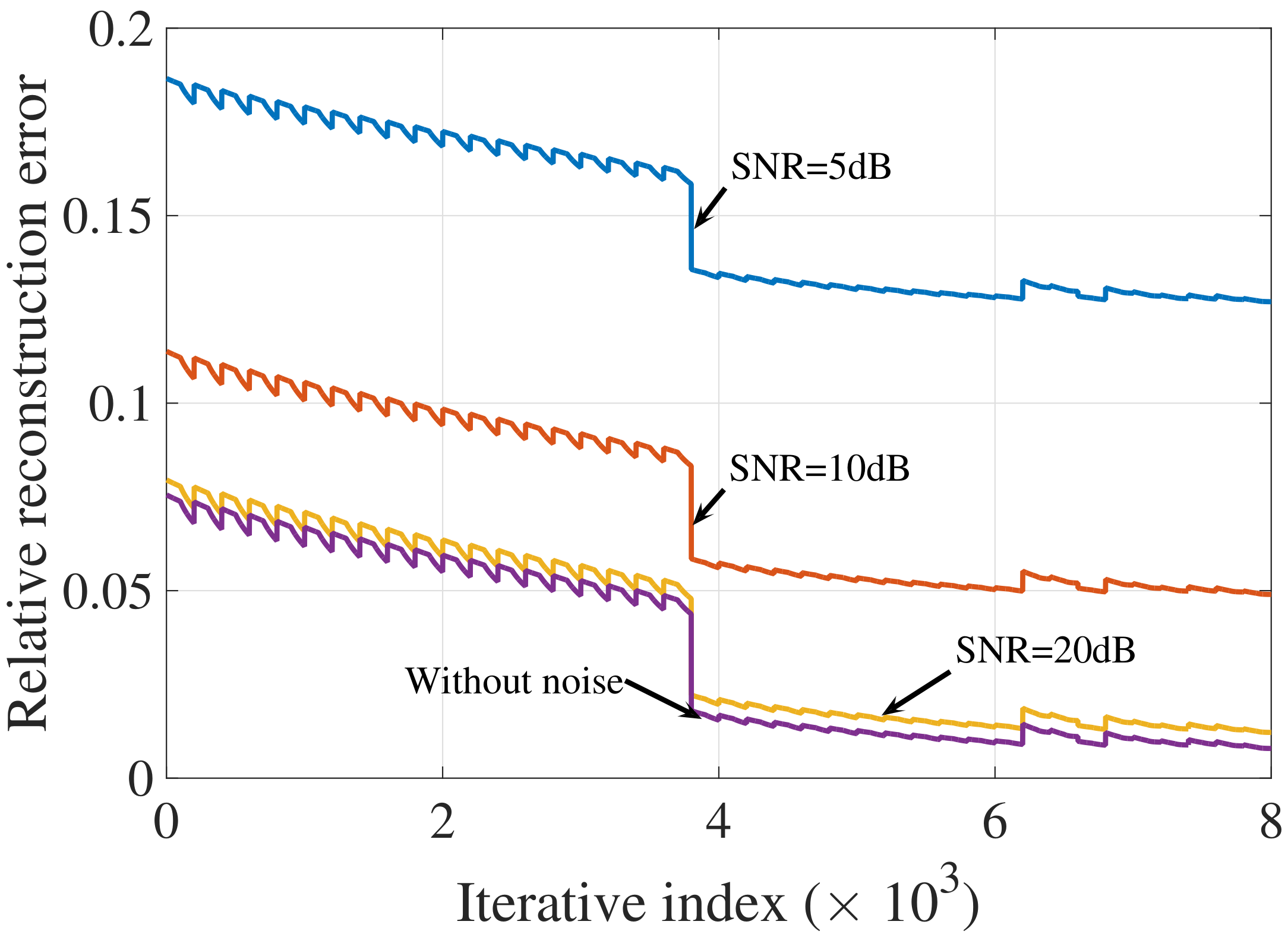
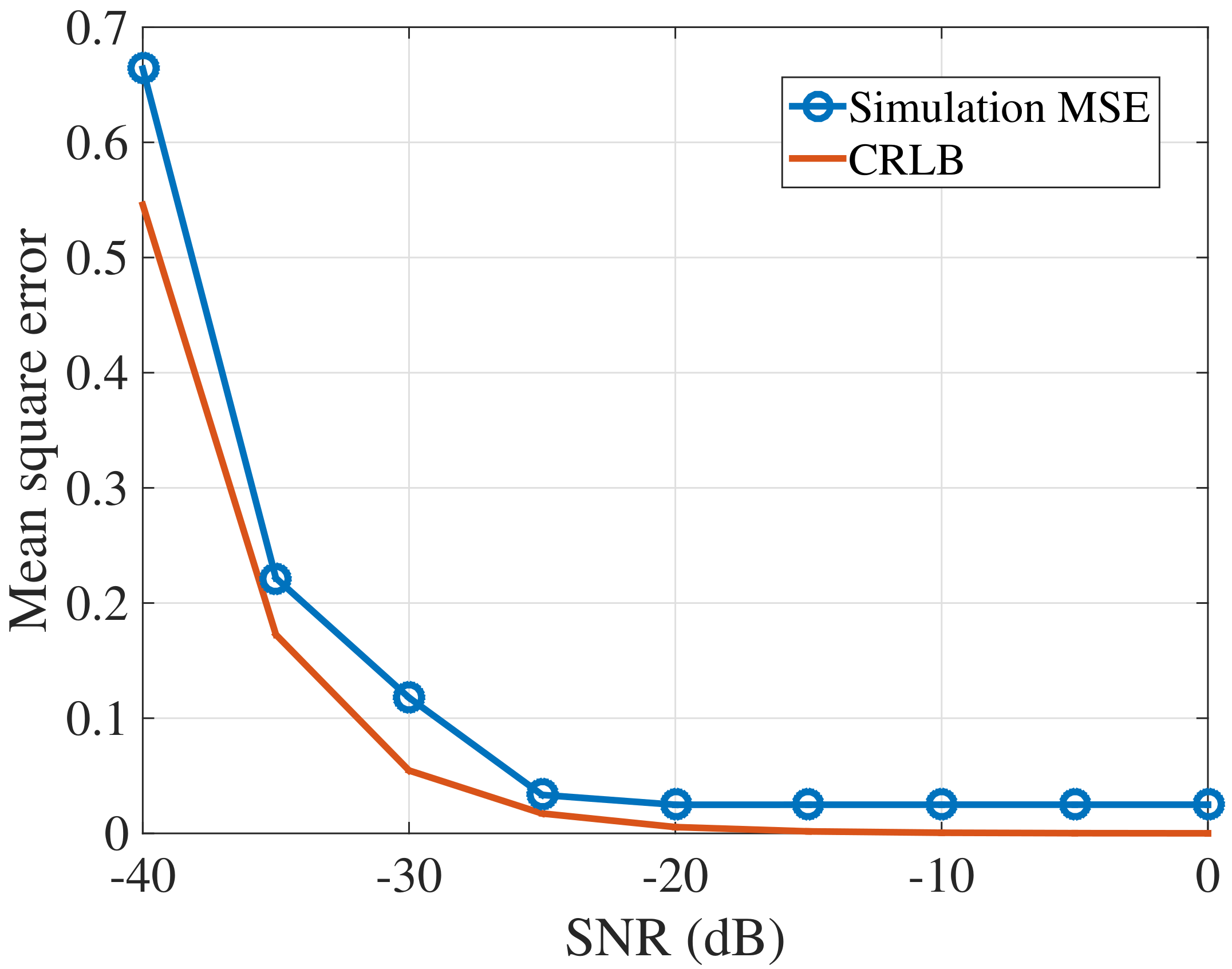
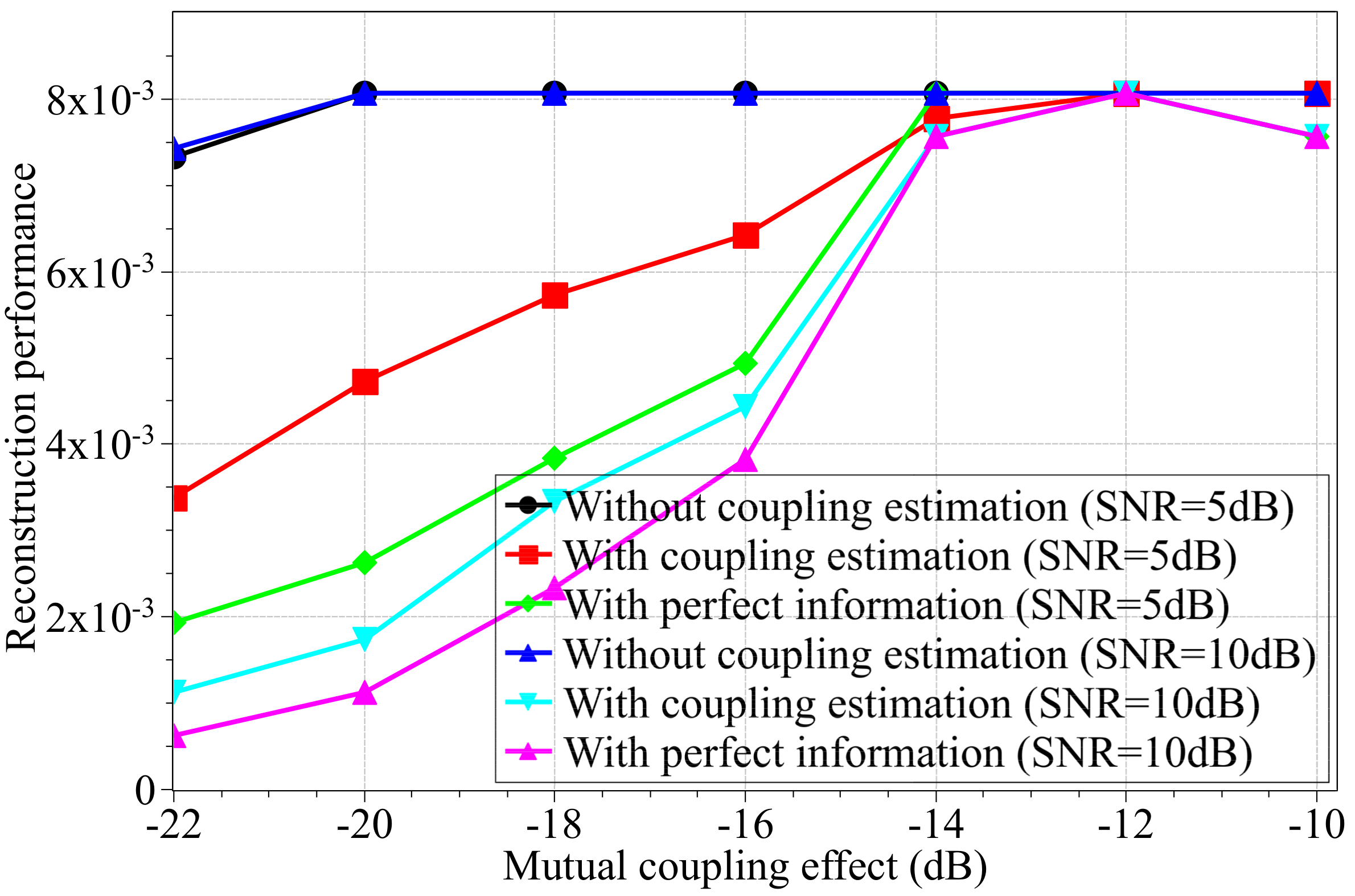
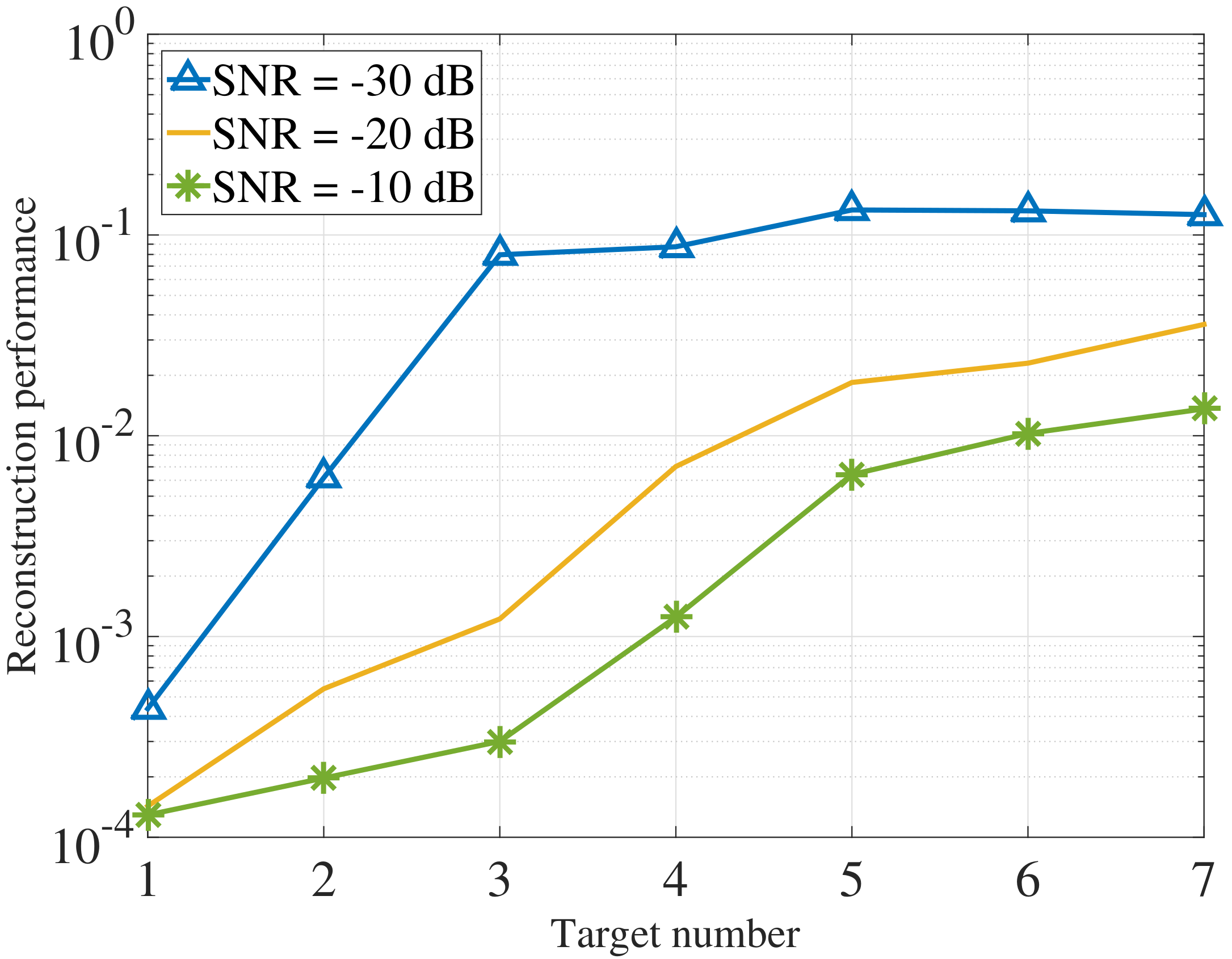
| Parameter | Value |
|---|---|
| Carrier frequency | 1 GHz |
| Speed of waveform c | m/s |
| Wavelength | m |
| Pulse number P | 100 |
| Antenna space d | m |
| Antenna number in transmitter M | 20 |
| Antenna number in receiver N | 20 |
| Dictionary resolution | |
| Detection angle range | 30°∼60° |
| Iteration number | |
| Target number K | 2 |
© 2018 by the authors. Licensee MDPI, Basel, Switzerland. This article is an open access article distributed under the terms and conditions of the Creative Commons Attribution (CC BY) license (http://creativecommons.org/licenses/by/4.0/).
Share and Cite
Chen, P.; Cao, Z.; Chen, Z.; Yu, C. Sparse DOD/DOA Estimation in a Bistatic MIMO Radar With Mutual Coupling Effect. Electronics 2018, 7, 341. https://doi.org/10.3390/electronics7110341
Chen P, Cao Z, Chen Z, Yu C. Sparse DOD/DOA Estimation in a Bistatic MIMO Radar With Mutual Coupling Effect. Electronics. 2018; 7(11):341. https://doi.org/10.3390/electronics7110341
Chicago/Turabian StyleChen, Peng, Zhenxin Cao, Zhimin Chen, and Chunhua Yu. 2018. "Sparse DOD/DOA Estimation in a Bistatic MIMO Radar With Mutual Coupling Effect" Electronics 7, no. 11: 341. https://doi.org/10.3390/electronics7110341
APA StyleChen, P., Cao, Z., Chen, Z., & Yu, C. (2018). Sparse DOD/DOA Estimation in a Bistatic MIMO Radar With Mutual Coupling Effect. Electronics, 7(11), 341. https://doi.org/10.3390/electronics7110341







